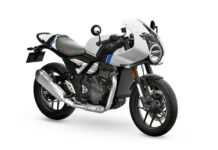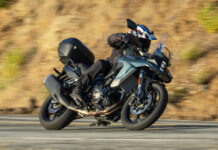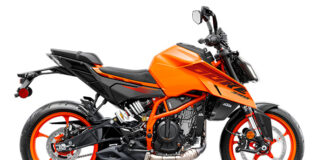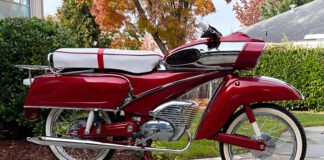As cool as it is to ride a sportbike on the track, all decked out in leathers and doing my damnedest to grind down my knee pucks, that is a special occasion. My bread and butter riding is done on the street, so I appreciate amenities that make my sport riding more pleasant. Rather than 20-minute track sessions, I ride until the low-fuel light comes on. Build a bike that accommodates my 34-inch inseam legs, with a seat that doesn’t induce blasphemous ranting and ergonomics that do not demand a mastery of yoga, and you’ll get my attention. But don’t sacrifice performance for comfort. Daddy likes power, and he wants it in a svelte package with high-quality suspension and stout brakes.
If I could design my ideal sportbike on a home computer like Gary and Wyatt designed their dream girl in Weird Science, it might end up a lot like the new BMW K 1300 S. It meets the aforementioned criteria, yet goes above and beyond. Electronically adjustable suspension? Sure, why not. How about ABS, traction control and a quick-shifter? Oh BMW, now you’re trying to spoil me! This is really cool stuff that contributes to a highly refined, wickedly fun go-fast experience.
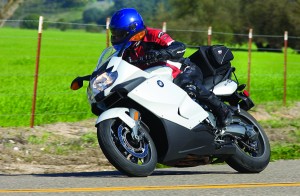
With a seat height of 32.2 inches (a 31.1-inch low seat is a no-cost option), the K 1300 S allows me to firmly plant my outrigger legs at stoplights, but the seating position isn’t cramped. The long wheelbase provides plenty of room for me to stretch out, and the seat is one of the coziest saddles my keister has ever met. Fiddle with the adjustable brake and clutch levers, set the imminently useful and clear mirrors and grab clip-ons that are well-spaced and purposefully but not uncomfortably low. In a truly perfect world, the S would have handlebar adjustability like on the GT for additional height and pull-back on long rides.
Mmmm, power‚ delicious low-cal, high-protein power. BMW claims peak figures of 175 horsepower at 9,250 rpm and 103 lb-ft of torque at 8,250 rpm. Jett Tuning’s Dynojet dynamometer recorded 153.8 horsepower at 9,800 rpm and 92.1 lb-ft of torque at 8,000 rpm.
Unusual on a sportbike, the nonjacking Paralever shaft drive eliminates the need for chain lubrication, adjustment and replacement. From 5,200 to 10,000 rpm, 80-92 lb-ft of torque delivers immediate, highly addictive roll-on power in a smooth, linear manner. Yes, there are some dips in the horsepower and torque curves, but they are much less noticeable from the saddle than they are staring at this magazine.

Gone is the howitzer exhaust that used to extend beyond the rear tire. It has been replaced with a shorter, hexagonally shaped pipe with an integrated three-way catalytic converter. The full stainless-steel system weighs 20.7 pounds and includes an electronically controlled exhaust butterfly valve to boost torque. Given the similarity of the horsepower and torque curves between the S and the BMW K 1300 GT, we surmise that the different exhaust setups are largely responsible for the higher figures on the S model. If “stock exhaust” is not part of your vocabulary, then bust out your gold card and order up the accessory Akrapovic titanium slip-on with carbon cover.
We could all use a little help from time to time. To more easily put all that horsepower and torque to good use, BMW offers an optional Gear Shift Assistant. More colloquially known as a quick-shifter, this ‘lil buddy is much more useful than Microsoft’s Office Assistant. Unlike that animated, googly eyed paperclip that makes you want to punch your computer screen, the Gear Shift Assistant helps you punch the hyperspace button. Grab as much throttle as you can stand and simply tap up through the gears. The Gear Shift Assistant uses a Hall-effect switch to briefly cut injection and ignition for smooth, clutchless upshifts. You don’t have to use it-electronic wizardry disables it when the clutch is engaged-but take it from me, it will become your new BFF.
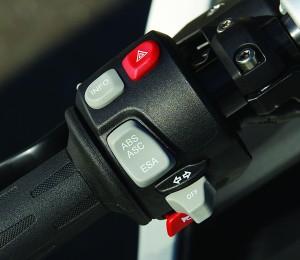
Since many riders would rather not bother with spanners and screwdrivers to make suspension adjustments every time their mood or load capacity changes, BMW’s ESA II makes life easier. Just push the button to dial in preload (rider, luggage, passenger) and damping (Comfort, Normal, Sport). In rider-only mode, the three damping options are like Goldilocks and the Three Bears. Sport is Papa Bear’s bed: too stiff, like a stone being skipped down the road; Comfort is Mama Bear’s bed: soft and suitable for a plush ride; and Normal is Baby Bear: just right. Another nice-to-have is Anti-Spin Control (ASC), also known as traction control. Not being the kind of guy who leaves long darkies on corner exits, I tested it in a patch of gravel. With ASC on, the engine bogged and the rear tire wouldn’t spin; with it off, I ripped a huge, rocky burnout. There when you need it, turn if off when you don’t.
Editor Tuttle has had to put up with the three-button BMW turn signals for a lot more years than I have, so I won’t steal his thunder regarding the new, single-button, self-canceling turn signals. During the tech presentation at the K 1300 S/GT intro, Marketing Manager Todd Anderson toed the party line and declared that the three-button setup is, in fact, superior. Rather than admit defeat, BMW says the move is part of its strategy to win over new customers. According to Anderson, BMW didn’t want new riders to “spend 12 minutes of a 15-minute demo ride trying to figure out how to work the turn signals.”
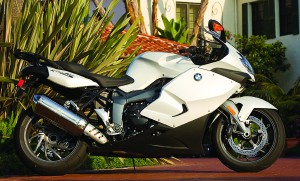
As with the handlebar adjustability, I prefer the gauges from the GT, which are easy to read with conventional needle positions. The redesigned gauges on the S-a gray-faced tach and white-faced speedo-have needles that begin their circular sweep at the 4:00 position rather than the usual 6:00 position. And the speedo is very busy looking with lots of tick marks and a crowd of numbers. Owners will need to calibrate their brains accordingly since it is very easy to get deep into triple-digit speeds. Other cosmetic changes include an 18mm-narrower upper fairing and new cockpit trim, side fairings and LED taillight. For 2009 there are three colors to choose from: Light Grey Metallic (shown), Lava Orange and (for an extra $650) Metallic and Sapphire Black/Granite Gray/Magma Red.
Riding the new K 1300 S is a real pleasure. Its blend of refinement, comfort, power and innovation won me over. Hustling it through my favorite set of curves, the K 1300 S handles gracefully and predictably, blasts out of corners and down straights with a vengeance and puts my mind at ease with anti-lock brakes and traction control. The quick-shifter and heated grips pamper me when I get lazy or cold, and the on-board computer keeps me well-informed, though it doesn’t allow me to update my Facebook status. Now only if BMW could arrange a two-up ride with Kelly LeBrock.
Click here to see Greg’s video from the K 1300 S and K 1300 GT intro (April 15 episode of Rider 360).
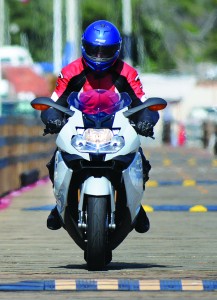
Base Price: $15,250
Price as Tested: $17,400 (Gear Shift Assistant, Anti-Spin Control, ESA II, heated grips, luggage rack)
Seat Height: 32.2 inches (31.1-inch low seat is a no-cost option)
Wet Weight: 567 lbs.
Load Capacity: 445 lbs.
GVWR: 1,012 lbs.
Fuel Capacity: 5.0 gals., last 1.0 gal. warning light on
Average mpg: 35.1
Estimated Range: 176 miles
Indicated rpm at 60 mph: 3,750
Also check out the full BMW K 1300 GT specifications chart on ridermag.wpengine.com.
If you are interested in the 2009 BMW K 1300 S Review, you might also be interested in the 2009 BMW K 1300 GT.

